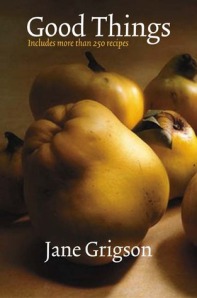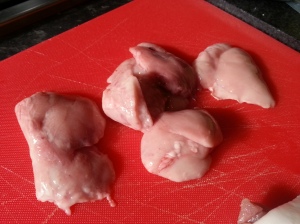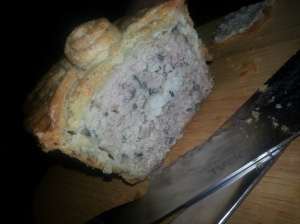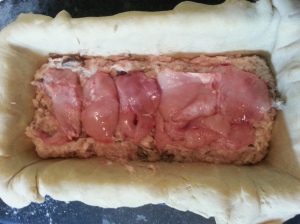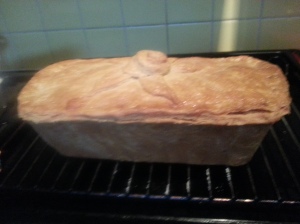This is not a manual of cookery, but a book about enjoying food. Few of the recipes in it will contribute much to the repertoire of those who like to produce dinner for 6 in 30 minutes flat. I think food, its quality, its origins, its preparation, is something to be studied and thought about in the same way as any other aspect of human existence.
Jane Grigson, introduction to Good Things, 1970
Good Things was Jane Grigson second book and was published in 1971. Although she is known for her later extensive and very comprehensive writings, this is relatively brief.
All of Jane Grigson books are wonderful, and this book is no different: logical, creative, witty and sometimes austere, she weaves a tapestry of each ingredient’s culinary potential; and this is why the book is so great, for each chapter focusses upon a single main ingredient. She shows you just how inventive humans can be with a single ingredient and how it should be savoured in its seasonality to be fully appreciated; something we no longer do. This book has spurred me on in my own efforts to be seasonal. Take, for example, the chapter on celery – a vegetable that we generally either add to the stockpot or crunch on in a boring salad – she says:
The fine pleasure of buying celery in earthy heads, after the first improving frosts of winter, is slowly being eroded by the wash of enterprise and aviation. Almost the year round, cleaned and slightly flabby greenish celery…is on sale at inviting prices. It’s the wise cook who averts her eyes from this profuse and plastic display and waits for November. Then crispness and flavour are at their peak …In any case one of the greatest luxuries you can have in Britain today is simple food of the best quality.’
She then goes onto her first recipe which consists of celery stalks, good Normandy butter and sea salt. This is the genius of Good Things, you are being shown how good something can be if prepared properly, grown skilfully and eaten seasonality and sensibly; essentially Jane is teaching us how to eat.
(NB, click here for a post of my own on the humble celery stick).
Every chapter also perfectly reflects Jane’s own lifestyle; spending half her time between England and France, with a smattering of recipes from other European countries. It really showed how she lived her life, though I can imagine her family got a little sick of some of the focal ingredients when she was recipe testing.
Sweetbreads: a Jane Grigson – and Neil Buttery – favourite
So what did she pick? Some are probably quite obvious such as venison, asparagus, woodland mushrooms, strawberries and ice creams; others are common and, perhaps, overlooked, like celery, kippers, tomatoes and carrots; whilst some were becoming forgotten or seemed obscure, ones that leap to mind are snails, quince, sweetbreads and fruit liqueurs. Jane’s gift to me is a love of such foods that I never would have sought out, that has demonstrated to me just how good, exciting and varied British food can be, as well as how its history is interlinked inextricably with other countries’ food histories.
Sweetbread Pie
I think this recipe best sums up the essence and ethos of Good Things; it uses a delicious but forgotten meat cut, is French but you would think it quintessentially English. She discovered it in the charcuterie of a small town in Burgandy and it was the most expensive pâté in the shop. She made it into a pie, a pie so good it made it on my last Pop-Up Restaurant menu. The recipe requires you prepare some sweetbreads – if you’ve never eaten or prepared sweetbreads, have a look at this previous post all about them. In a nutshell, you poach them briefly in a light chicken or vegetable stock, or court-bouillon. For a post on stock-making click here. I am so self-referential these days! If you can’t get as much as the 500g given in the recipe, then use whatever you can get your hands on. I expect it would be excellent even with the sweetbreads omitted altogether!
I have changed only her Imperial weights and measures so that they are metricated…
For the pastry:
300g plain flour
150g of butter and lard
1 tbs icing sugar
water to bind
For the filling:
500g prepared lambs’ or calves’ sweetbreads
125g mushrooms, roughly chopped
2 tbs onion, finely chopped
1 garlic clove, crushed
75g butter
350g lean pork, or veal and pork mixed
225g hard back pork fat
2 rashers green (i.e. unsmoked) back bacon
2 eggs
heaped tbs flour
125g cream
salt, pepper and thyme.
‘Make the pastry in the usual way’, says Jane. I mean to write a post on pastry-making, I shall endeavour to do so soon. Whilst it rests in the fridge, cut up the sweetbreads into even-sized pieces, then cook the mushrooms onions and garlic in the butter, until softened but not brown. Next, make the forcemeat by mincing the pork and veal, if using, the back fat and the bacon through the course and then fine blades. Mix in the eggs, flour, cream and the mushroom mixture. Season with salt and pepper and add a good sprinkle of chopped thyme.
Line a 450g loaf tin (an old 1 lb tin) with 2 thirds of the pastry. Spread over one third of the mixture over the base of the tin, then a layer of half of the sweetbreads, then a second third of the forcemeat, then the remaining sweetbreads, and lastly the final third of the pork mixture.
Seal the pie with a lid, brush with egg wash and bake for 90 minutes in a moderate oven – around 180⁰C.
‘Serve warm’, she says, but it is also very good at room temperature. It keeps very well in the fridge if wrapped up tightly in foil or clingfilm.
If you like the blogs and podcast I produce, please consider treating me to a virtual coffee or pint, or even a £3 monthly subscription: follow this link for more information.

